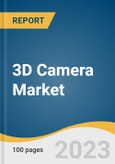The global 3D camera market size is expected to reach USD 140.40 billion by 2030. The market is expected to grow at a CAGR of 32.6% from 2023 to 2030. The market is growing due to the high product demand in virtual reality (VR), augmented reality (AR), and 3D printing. The increasing adoption of technologies, such as autonomous vehicles, drones, and robotics, drives market growth. In addition, the demand for 3D cameras in the healthcare sector has been on the rise in recent years. This is mainly due to the various benefits that 3D imaging provides over traditional 2D imaging in medical applications.
3D cameras have enabled medical professionals to capture and analyze images, more precisely and accurately, leading to better diagnosis and treatment. This has resulted in increased product demand in the healthcare industry. Manufacturers are heavily investing in the research and development of advanced 3D cameras that can capture images with better resolution and greater depth perception. Furthermore, with the rise in demand for 3D technology across various industries, manufacturers are developing affordable, user-friendly, portable, and high-quality 3D cameras. Smartphone manufacturers are focusing on incorporating 3D sensors into their products.
Social media and online shopping are already being impacted by the first generation of AR, which uses conventional rear-facing cameras. IKEA, for instance, launched IKEA Place, which allows consumers to virtually place and arrange furniture in their space before they purchase it. This drives the demand for 3D sensing technology, subsequently driving the market growth. In January 2023, Orbbec launched its high-resolution 3D camera, the Femto Magna, at the Consumer Electronics Show (CES). The 3D cameras comprise Microsoft and NVIDIA technologies and enable easier access to sensing technology, rendering them suitable for logistics, robotics, retail, manufacturing, fitness systems, and healthcare. Major companies in the market are focusing on new product launches, capacity expansions, and technological innovations.
3D cameras have enabled medical professionals to capture and analyze images, more precisely and accurately, leading to better diagnosis and treatment. This has resulted in increased product demand in the healthcare industry. Manufacturers are heavily investing in the research and development of advanced 3D cameras that can capture images with better resolution and greater depth perception. Furthermore, with the rise in demand for 3D technology across various industries, manufacturers are developing affordable, user-friendly, portable, and high-quality 3D cameras. Smartphone manufacturers are focusing on incorporating 3D sensors into their products.
Social media and online shopping are already being impacted by the first generation of AR, which uses conventional rear-facing cameras. IKEA, for instance, launched IKEA Place, which allows consumers to virtually place and arrange furniture in their space before they purchase it. This drives the demand for 3D sensing technology, subsequently driving the market growth. In January 2023, Orbbec launched its high-resolution 3D camera, the Femto Magna, at the Consumer Electronics Show (CES). The 3D cameras comprise Microsoft and NVIDIA technologies and enable easier access to sensing technology, rendering them suitable for logistics, robotics, retail, manufacturing, fitness systems, and healthcare. Major companies in the market are focusing on new product launches, capacity expansions, and technological innovations.
3D Camera Market Report Highlights
- The Time of Flight (ToF) technology segment is projected to register a CAGR of 34.9% from 2023 to 2030. Leading ToF cameras have been instrumental in the development of cameras with advanced sensors for depth measurement and object identification
- The professional camera segment held a market share of 63.9% in 2022 owing to its wide usage in VR and AR to capture the geometry of a scene and create immersive experiences
- The Asia Pacific region is expected to register the fastest growth rate during the forecast period
- This is owing to several factors, such as increasing penetration of smartphones, increasing disposable income, and low camera ownership
Table of Contents
Chapter 1. Methodology and Scope
Chapter 2. Executive Summary
Chapter 3. 3D Camera Market Variables, Trends & Scope
Chapter 4. Consumer Behavior Analysis
Chapter 5. 3D Camera Market: Technology Estimates & Trend Analysis
Chapter 6. 3D Camera Market: Application Estimates & Trend Analysis
Chapter 7. 3D Camera Market: Regional Estimates & Trend Analysis
Chapter 8. Competitive Analysis
List of Tables
List of Figures
Companies Mentioned
- Sony Corporation
- Canon Inc.
- Samsung Electronics Co., Ltd.
- LG Electronics
- NIKON CORPORATION
- Panasonic Corporation
- GoPro, Inc.
- FUJIFILM Corporation
- Eastman Kodak Company
- Orbbec 3D Technology International, Inc.
Methodology

LOADING...
Table Information
| Report Attribute | Details |
|---|---|
| No. of Pages | 100 |
| Published | August 2023 |
| Forecast Period | 2022 - 2030 |
| Estimated Market Value ( USD | $ 14.67 Billion |
| Forecasted Market Value ( USD | $ 140.4 Billion |
| Compound Annual Growth Rate | 32.6% |
| Regions Covered | Global |
| No. of Companies Mentioned | 10 |









